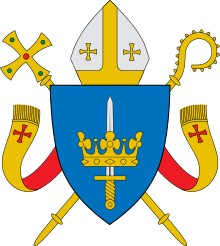Reduction of Gustav I of Sweden
The Reduction of Gustav I of Sweden, was an important reform during the Protestant Swedish Reformation, in which king Gustav I of Sweden ordered for a reduction of church property and land to the crown. This was a major reform which made the church in Sweden dependent upon the crown. It was also, in practice, the end of monastic life in Sweden. It was, in effect, the organisation of the confiscation of the property of the Swedish Catholic church and transfer of church property to the Crown, and the economic phase of the Swedish Reformation. The reform was introduced in 1527, proceeded through the 1530s, and was finalized in the 1540s. It was followed by the Örebro Synod, which, in contrast to this reform, dealt with the theological side of the reformation.
The reduction
The goal of the reduction was that all church property was to be transferred of the crown, and the independent property of the clergy was to be replaced by an allowance or salary by the crown, making the church dependent of the crown.
However, the king also wished to strengthen the position of the Swedish nobility, and therefore also allowed for all donations made to the church from private benefactors since the reign of Charles VIII of Sweden to be retracted by the benefactors or the families and descendants of the benefactors, enabling families of the nobility to retract lands and estates their ancestors had donated to churches, bishops and convents.
Property of Bishops
The origin of the reform was initiated at the Västerås riksdag of 1527. In the Reduction, all goods, lands and assets, particularly the formerly clerical castles, estates and strongholds belonging to the Bishops ad cathedrals, where to be regarded as Crown property, and the Bishops where from henceforth be provided for by the crown rather than from their own goods, in effect making the church economically dependent on the monarch. This transition was introduced in stages, often under vacancies of the office, when a bishop died and was succeeded by another.
Property of Convents
The property belonging to the monastic institutions in Sweden were also subject to the same rules, and the lands and property belonging to the Catholic convents of the monks and nuns were declared property of the crown. Each convent would be placed under the supervision of a nobleman who were to manage the former convent property for the crown, and while the monks and nuns where allowed to remain in their old convent building under government protection and a state allowance, the monastic communities effectively lost their economic independence, and started to die out. The reform was therefore in effect the dissolution of the Swedish convents.
The rule that allowed for the families of former benefactors to retract land and property donated to the church was particularly damaging to the convents.
Property of local churches and shrines
From 1539, the final stage was introduced, in which the property of local vicars was also declared crown property, and valuables were confiscated from the local churches and shrines, a visible mark of the reformation, which caused opposition among the peasantry and public, and contributed to the Dalecarlian rebellions and the Dacke War.
References
- Reduktion, hist., 6. Gustaf Vasas reduktion från kyrkan i Nordisk familjebok (andra upplagan, 1915)

